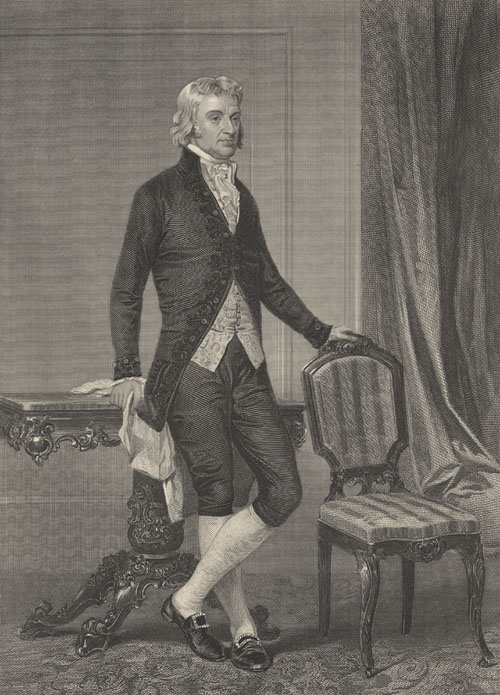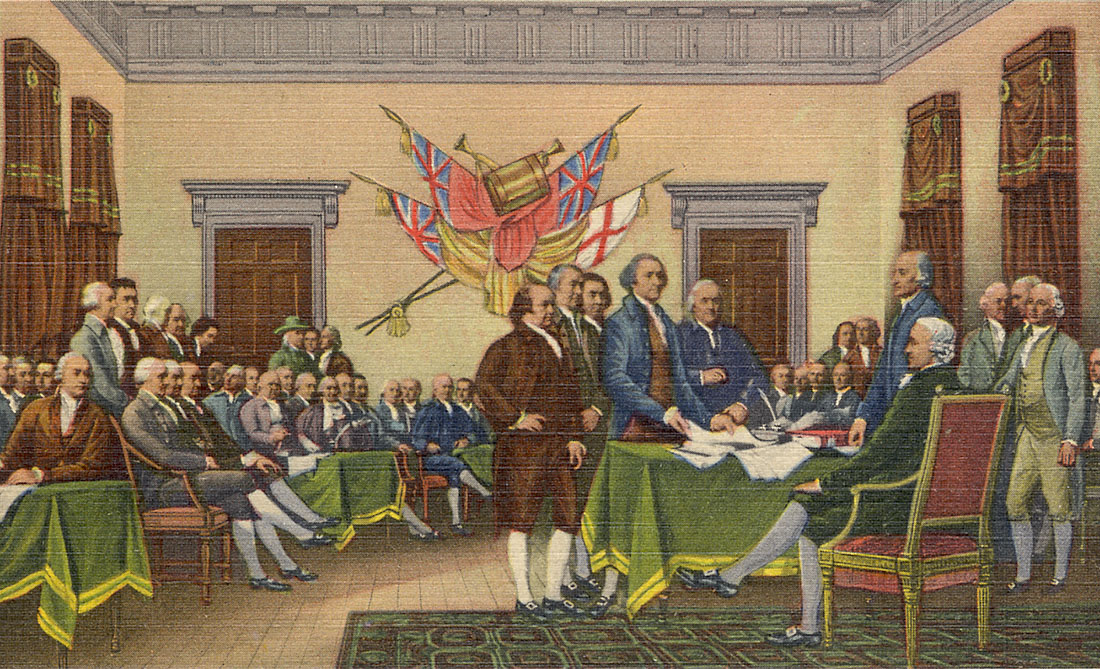 |
|
|
 |
|
|

|
|
|
| ||||
Chancellor Robert R. Livingston, Jr. |

|
|
| Livingston, Robert R. (1746-1813), U.S. statesman and diplomat, great-grandson of the prominent colonial figure Robert Livingston, born in New York City, and educated at King's College (now Columbia University). He was a lawyer and a member of the Continental Congress from 1775 to 1777 and from 1779 to 1781. During his first term he was also one of five members of the committee that drew up the Declaration of Independence. He was chancellor of New York State from 1777 to 1801, U.S. secretary of foreign affairs under the Articles of Confederation from 1781 to 1783, and minister to France from 1801 to 1804. In the last-named post he successfully negotiated the Louisiana Purchase by the United States. He financed the American engineer Robert Fulton in the building of his steamboat and for some time held a monopoly on Hudson River navigation. |



|
|
|
Robert of Clermont's only child, Robert R. Livingston (1718 - 1775), added to the
family's landholdings when he married Margaret Beekman heir to immense tracts
of land in Dutchess and Ulster counties, in the
1740s. Clermont's second owner was known to his
contemporaries as Judge of the Admiralty Court and
Judge of the Supreme Court of the Province of New
York. Judge and Margaret Beekman Livingston's
eldest son, Robert R. Livingston, Jr. (1746-1813),
was Clermont's most notable resident. A member of
the Committee of Five responsible for drafting the
Declaration of Independence, he also served as the
first United States Minister of Foreign Affairs
(Secretary of State) and, as Chancellor of the State of
New York, he gave the oath of office to George
Washington as first President of the United States.
Because of the Livingston family's prominent role in support of independence, Clermont was burned by British troops under the command of General John Vaughan during a foray up the Hudson River in the autumn of 1777. Margaret Beekman Livingston, who managed the estate during most of the war years. rebuilt the family home between 1779 and 1782. After independence was won, Chancellor Livingston began developing Clermont as an agriculture showplace. His experiments with sheep breeding and methods for increasing the yield of crops, while retaining the fertility of the soil, received national attention In 1792 the Chancellor began construction of an elaborate new mansion just south of the original house as the centerpiece of his experimental farm. Built in the shape of a capital "H." this house was also called Clermont It was destroyed by fire in 1909, but its ruins are still visible and indicate its size and grandeur. Chancellor Livingston concluded his public career as Thomas Jefferson's Minister to France between 1801 and 1804. While in Paris, he negotiated the Louisiana Purchase and entered into a partnership with Robert Fulton a Pennsylvania- born painter and inventor who shared Livingston's fascination with steam navigation. Their creation which they called the North River is known to history as the Clermont Their steamboat embarked on its maiden voyage between New York City and Albany in 1807, setting off a transportation revolution in the United States. Chancellor Livingston died at his Clermont estate in 1813. The original Clermont residence which had remained the home of Margaret Beekman Livingston until her death in 1800, was willed to the Chancellor's eldest daughter. |





|
|
|
Judge Livingston and his wife were blessed by a most remarkable group of children,--four sons and six daughter,--all of whom, when
married, settled upon the banks of the Hudson, extending from Staatsburg to Clermont. The oldest and youngest sons, Robert R. and
Edward, were prominent statesman. Robert R. Livingston was born in the city of New York on the 27th of November, 1746. He was
educated by the best teachers of the period, and afterwards at King’s (now Columbia) College, then under the presidency of Myles
Cooper, of Revolutionary celebrity, where he graduated, in 1764, at the age of eighteen. He studied law under William Smith, the
historian of New York, and afterwards in the office of his relative, William Livingston, the distinguished, governor of New Jersey. On
the 9th of October, 1770, he married Miss Mary Stevens, daughter of Hon. John Stevens, of Hunterdon, N.J.
In October, 1773, he was admitted to the bar, and worked hard, becoming very eminent in his profession, and for a short time was in partnership with his intimate friend, John Jay. Soon after this he was appointed recorder of his native city, and was an early opponent of British oppression, taking a very active part in politics. In this situation the Revolution found him, so that both father and son relinquished at the same time important judicial stations to take part with their fellow-patriots in the liberation of their country. The delegates from the colony of New York to the Continental Congress, which met in Philadelphia in May, 1775, were John Jay, John Alsop, James Duane, Philip Schuyler, George Clinton, Lewis Morris, and Robert R. Livingston; and the weight of their talents and character may be inferred from the fact that Mr. Jay, Mr. Duane, Mr. Schuyler, and Mr. Livingston were placed upon the committees charged with the most responsible duties. Mr. Livingston took a leading part in the debates of the Congress. He was placed on the committee to prepare and report a plan for the confederation of the colonies, and was also a member of the committee appointed to draw up and prepare the Declaration of Independence. After the adoption of the Declaration of Independence the colony of New York was changed to a State, and Robert R. Livingston was placed upon the committee, with John Jay, Gouverneur Morris, Charles De Witt, and others, to draft and report the Constitution. Robert R. Livingston introduced into this instrument the section creating the council of revision, a body composed of the governor, chancellor, and judges of the Supreme Court, which sat to revise all bills about to be passed into laws by the Legislature, and of which he himself became a prominent member. The court existed till it was abolished by the convention of 1821, and its powers lodged solely in the hands of the governor by the constitution of that year. Mr. Livingston performed the labor of revising the draft of the State constitution of 1777,--not by any means an easy task, but one which required the best talent and learning to accomplish.
Chancellor Livingston was tendered the post of minister to France by President Washington, but saw fit to decline its acceptance; at a later period, however, after refusing the position of secretary of the navy in the cabinet of President Jefferson, he was prevailed upon to undertake the mission to France, and was appointed minister plenipotentiary to that government in 1801, resigning the chancellorship of New York to accept a post abroad. On his arrival in France he was received by Napoleon Bonaparte, then First Consul, with marked respect and cordiality. His ministry was signalized by the cession of Louisiana to the United States, which, through his negotiation, took place in 1803, adding all the immense territory west of the Mississippi river to our possessions. While in Paris he made the acquaintance of Robert Fulton, and a warm friendship grew up between then; together they successfully developed a plan for steam-navigation. Mr. Livingston had previously become deeply interested in the subject; he had constructed a boat, and had obtained of the Legislature of New York the exclusive right to navigate its water by steam-power for a period of twenty years. On meeting Fulton in France, he made him acquainted with what he had done in America, and, from his knowledge of Fulton’s mechanical genius, he advised him to turn his attention to the subject, which he did, and, after various experiments, the two together launched a trial boat on the Seine, which, however, did not meet their expectations; and it was not till after their return to America, in 1807, that the “Clermont” was built and launched upon the Hudson, and clearly demonstrated the feasibility of steam-navigation. Chancellor Livingston was the inventor, but the success of the invention was due to improvements suggested and made by Robert Fulton, and put in operation by the combined genius of the two great minds. It should be remembered, however, that Mr. Livingston was the prime mover, and was therefore instrumental in perfecting and bringing before the world one of the greatest discoveries of the age.

The retirement of Chancellor Livingston from public life was but the beginning of a new era of usefulness in his memorable career. During the remainder of his life he devoted much time and attention to the subject of agriculture, and was actively engaged in introducing a number of valuable improvements in that art into the State of New York. He was the principal founder of the American Academy of Fine Arts, established in the city of New York in 1801. And although giving almost the first impulse to art culture in this country, it was not in this that he was so much a benefactor as in his aid to the means of common subsistence derived from the cultivation of the soil, by his introduction of improvements in the theory and practice of husbandry. Like Washington, he took a deep interest in all that pertained to the welfare of his countrymen, but in an especial manner in agriculture.

His last work, written a few years previous to his death, was devoted to this subject. “Among the men of our common country who, by their deeds and fame, have added to the national glory and to the substantial welfare of the land, a pre-eminently conspicuous place will ever be assigned to Robert R. Livingston.”* He departed this life at Clermont, his seat on the Hudson, Feb. 26, 1813, in the sixty-sixth year of his age. He was buried in the old manor vault of the Livingston family at Clermont. |


![]() Copyright © 2003, InterMedia Enterprises
Copyright © 2003, InterMedia Enterprises